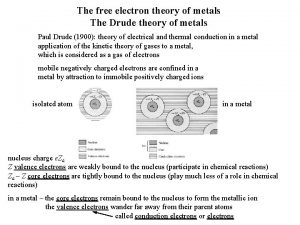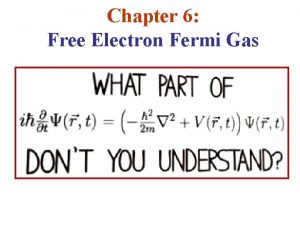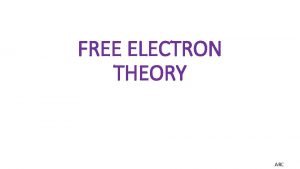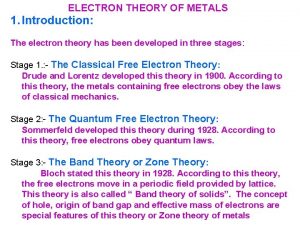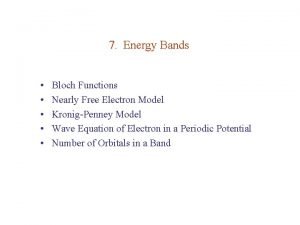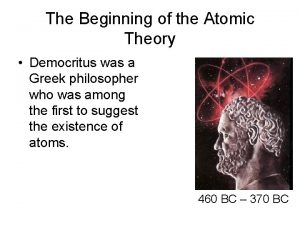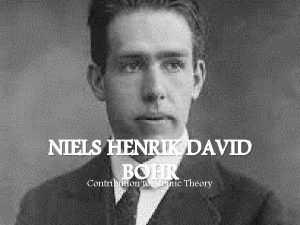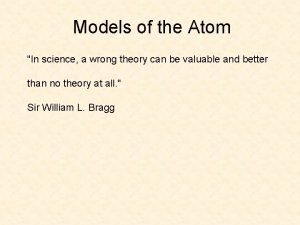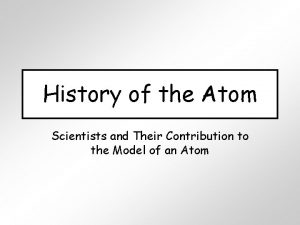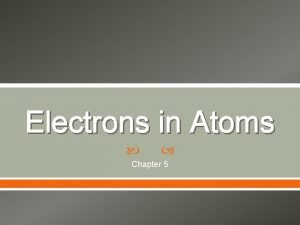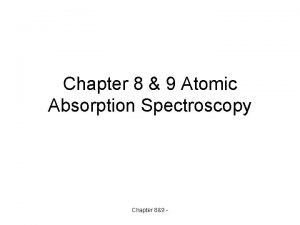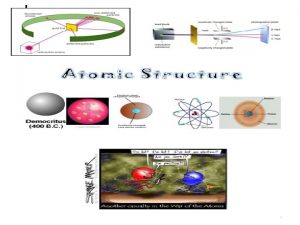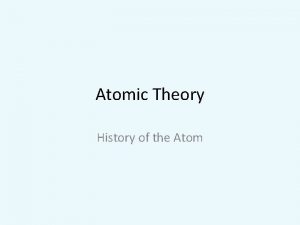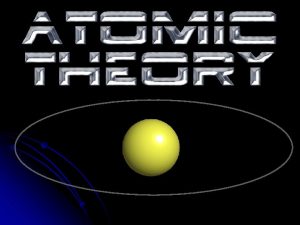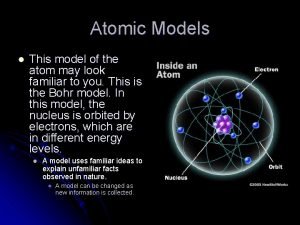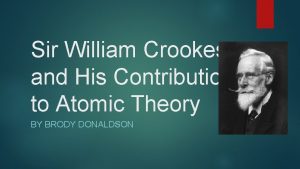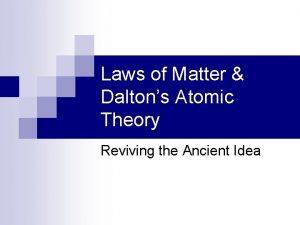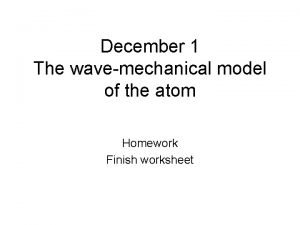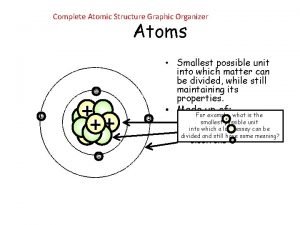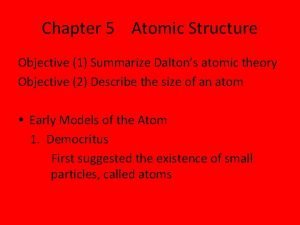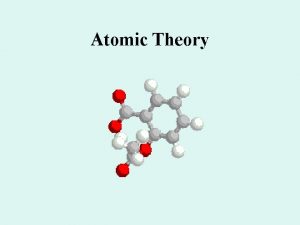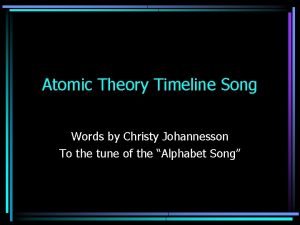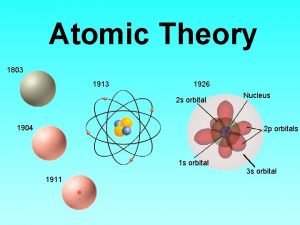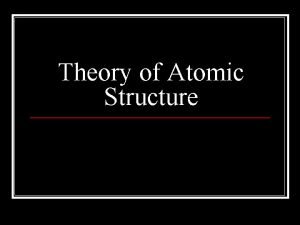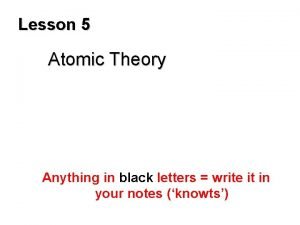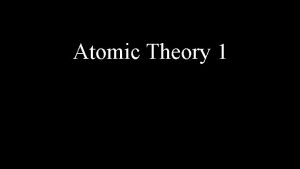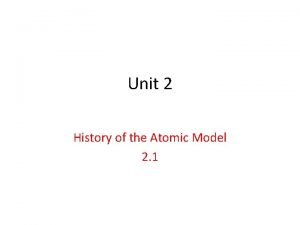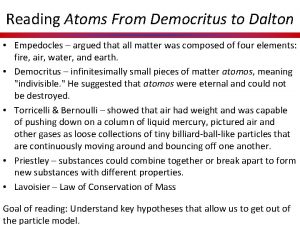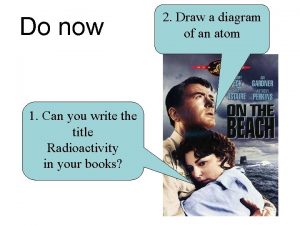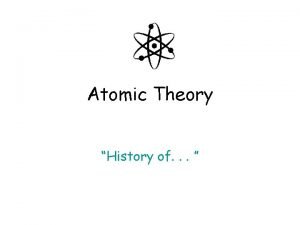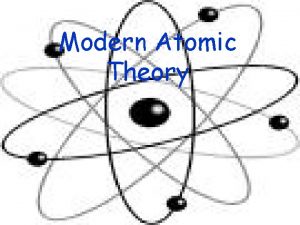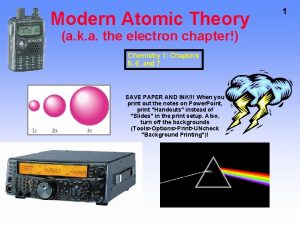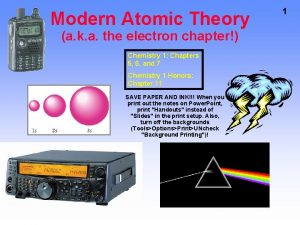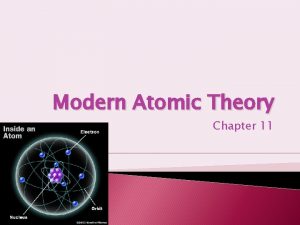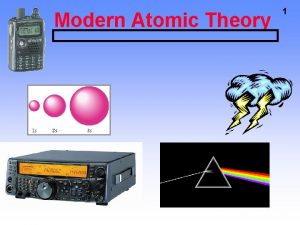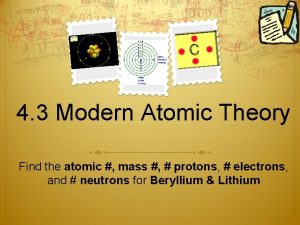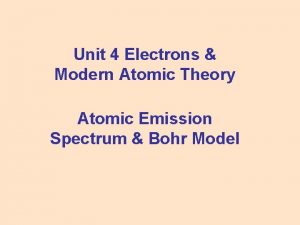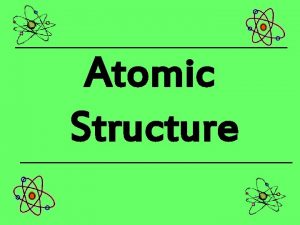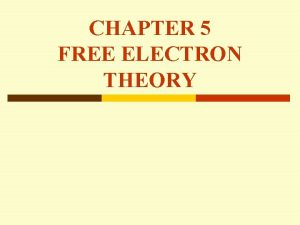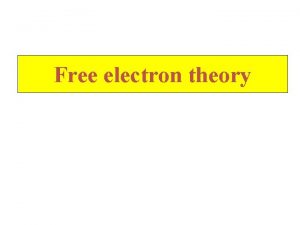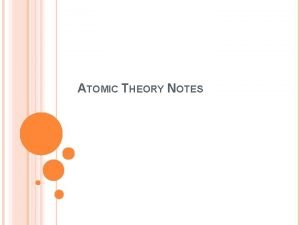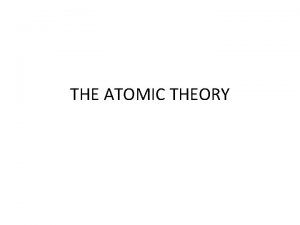Modern Atomic Theory a k a the electron





































































![74 Keep an Eye On Those Ions! • Tin Atom: [Kr] 5 s 2 74 Keep an Eye On Those Ions! • Tin Atom: [Kr] 5 s 2](https://slidetodoc.com/presentation_image/6af81af585a22292ae448cdaa689230d/image-70.jpg)
![Keep an Eye On Those Ions! • Bromine Atom: [Ar] 4 s 2 3 Keep an Eye On Those Ions! • Bromine Atom: [Ar] 4 s 2 3](https://slidetodoc.com/presentation_image/6af81af585a22292ae448cdaa689230d/image-71.jpg)







- Slides: 78

Modern Atomic Theory (a. k. a. the electron chapter!) Chemistry 1: Chapters 5, 6, and 7 Chemistry 1 Honors: Chapter 11 SAVE PAPER AND INK!!! When you print out the notes on Power. Point, print "Handouts" instead of "Slides" in the print setup. Also, turn off the backgrounds (Tools>Options>Print>UNcheck "Background Printing")! 1

2 The following information (slides 3 -16) could be used with pg. 6 -7 of Unit 3 note packet.

3 ELECTROMAGNETIC RADIATION

Electromagnetic radiation. 4

5 Electromagnetic Radiation • Most subatomic particles behave as PARTICLES and obey the physics of waves.

6 Electromagnetic Radiation wavelength Visible light Amplitude wavelength Ultaviolet radiation Node

7 Electromagnetic Radiation • Waves have a frequency • Use the Greek letter “nu”, , for frequency, and units are “cycles per sec” = c • All radiation: • where c = velocity of light = 3. 00 x 108 m/sec

Electromagnetic Spectrum Long wavelength --> small frequency Short wavelength --> high frequency increasing wavelength 8

9 Electromagnetic Spectrum In increasing energy, ROY G BIV

Excited Gases & Atomic Structure 10

Atomic Line Emission Spectra and Niels Bohr (1885 -1962) 11 Bohr’s greatest contribution to science was in building a simple model of the atom. It was based on an understanding of the LINE EMISSION SPECTRA of excited atoms. • Problem is that the model only works for H

12 Spectrum of White Light

Line Emission Spectra of Excited Atoms • Excited atoms emit light of only certain wavelengths • The wavelengths of emitted light depend on the element. 13

14 Spectrum of Excited Hydrogen Gas

15 Line Spectra of Other Elements

16 The Electric Pickle • Excited atoms can emit light. • Here the solution in a pickle is excited electrically. The Na+ ions in the pickle juice give off light characteristic of that element.

17 The following information (slides 18 -26) could be used with pg. 8 of Unit 3 note packet.

18 Atomic Spectra One view of atomic structure in early 20 th century was that an electron (e-) traveled about the nucleus in an orbit.

19 Atomic Spectra and Bohr said classical view is wrong. Need a new theory — now called QUANTUM or WAVE MECHANICS. e- can only exist in certain discrete orbits e- is restricted to QUANTIZED energy state (quanta = bundles of energy)

Quantum or Wave Mechanics 20 Schrodinger applied idea of ebehaving as a wave to the problem of electrons in atoms. He developed the WAVE EQUATION Solution gives set of math expressions called WAVE E. Schrodinger FUNCTIONS, 1887 -1961 Each describes an allowed energy state of an e-

Heisenberg Uncertainty Principle W. Heisenberg 1901 -1976 Problem of defining nature of electrons in atoms solved by W. Heisenberg. Cannot simultaneously define the position and momentum (= m • v) of an electron. We define e- energy exactly but accept limitation that we do not know exact position. 21

Arrangement of Electrons in Atoms Electrons in atoms are arranged as LEVELS (n) SUBLEVELS (l) ORBITALS (ml) 22

QUANTUM NUMBERS The shape, size, and energy of each orbital is a function of 3 quantum numbers which describe the location of an electron within an atom or ion n (principal) ---> energy level l (orbital) ---> shape of orbital ml (magnetic) ---> designates a particular suborbital The fourth quantum number is not derived from the wave function s (spin) ---> spin of the electron (clockwise or counterclockwise: ½ or – ½) 23

QUANTUM NUMBERS So… if two electrons are in the same place at the same time, they must be repelling, so at least the spin quantum number is different! The Pauli Exclusion Principle says that no two electrons within an atom (or ion) can have the same four quantum numbers. If two electrons are in the same energy level, the same sublevel, and the same orbital, they must repel. Think of the 4 quantum numbers as the address of an electron… Country > State > City > Street 24

25 Energy Levels • Each energy level has a number called the PRINCIPAL QUANTUM NUMBER, n • Currently n can be 1 thru 7, because there are 7 periods on the periodic table

26 Energy Levels n=1 n=2 n=3 n=4

27 The following information (slides 28 -41) could be used with pg. 8 -9 of Unit 3 note packet.

Relative sizes of the spherical 1 s, 2 s, and 3 s orbitals of hydrogen. 28

29 Types of Orbitals • The most probable area to find these electrons takes on a shape • So far, we have 4 shapes. They are named s, p, d, and f. • No more than 2 e- assigned to an orbital – one spins clockwise, one spins counterclockwise

30 Types of Orbitals (l) s orbital p orbital d orbital

p Orbitals 31 this is a p sublevel with 3 orbitals These are called x, y, and z 3 py orbital There is a PLANAR NODE thru the nucleus, which is an area of zero probability of finding an electron

p Orbitals • The three p orbitals lie 90 o apart in space 32

33 Copyright © 2007 Pearson Benjamin Cummings. All rights reserved.

d Orbitals • d sublevel has 5 orbitals 38

39 The shapes and labels of the five 3 d orbitals.

40 f Orbitals For l = 3, ---> f sublevel with 7 orbitals

41

42 The following information (slides 43 -47) enhances general understand of this topic/powerpoint up to this point (links it to the Periodic Table).

43 Quantum Numbers • Orbitals combine to form a spherical shape. 2 s 2 px 2 py 2 pz Courtesy Christy Johannesson www. nisd. net/communicationsarts/pages/chem

44 Copyright © 2006 Pearson Benjamin Cummings. All rights reserved.

45 s, p, and d-orbitals A s orbitals: Hold 2 electrons (outer orbitals of Groups 1 and 2) Kelter, Carr, Scott, , Chemistry: A World of Choices 1999, page 82 B p orbitals: Each of 3 pairs of lobes holds 2 electrons = 6 electrons (outer orbitals of Groups 13 to 18) C d orbitals: Each of 5 sets of lobes holds 2 electrons = 10 electrons (found in elements with atomic no. of 21 and higher)

Orbitals and the Periodic Table • Orbitals grouped in s, p, d, and f orbitals (sharp, proximal, diffuse, and fundamental) s orbitals f orbitals d orbitals p orbitals 46

Periodic table arrangement 47 • the quantum theory helps to explain the structure of the periodic table. • n - 1 indicates that the d subshell in period 4 actually starts at 3 (4 - 1 = 3).

48 The following information (slides 49 -56) could be used with pg. 9 -11(top) of Unit 3 note packet.

Orbital Diagrams • Graphical representation of an electron configuration • One arrow represents one electron • Shows spin and which orbital within a sublevel • Same rules as before (Aufbau principle, d 4 and d 9 exceptions, two electrons in each orbital, etc. ) 49

To start we will use orbital filling diagrams to help us with electron configurations…. • Example Boron- has 5 electrons 50

51 We must follow 3 rules… Aufbau priciple • Electrons occupy energy levels with lowest energy first.

52 Hund’s rule… rule • Electrons that occupy orbitals of the same energy will have the maximum number of electrons with the same spin.

Pauli exclusion principle • If 2 electrons occupy the same energy level they must have opposite spins. 53

Lithium 54 Group 1 A Atomic number = 3 1 s 22 s 1 ---> 3 total electrons

Carbon Group 4 A Atomic number = 6 1 s 2 2 p 2 ---> 6 total electrons Here we see for the first time HUND’S RULE. When placing electrons in a set of orbitals having the same energy, we place them singly as long as possible. 55

Ion Configurations 56 To form anions from elements, add 1 or more efrom the highest sublevel. P [Ne] 3 s 2 3 p 3 + 3 e- ---> P 3 - [Ne] 3 s 2 3 p 6 or [Ar]

57 The following information (slides 58 -69) could be used with pg. 11 -12 of Unit 3 note packet.

58 Electron Configuration A detailed way of showing the order in which electrons fill in around the nucleus

59 Electron Configuration Symbols 2 1 s Energy Level # of e- in sub level Sub Level (s, p, d, f )

Electron Configurations 4 2 p Energy Level 60 Number of electrons in the sublevel Sublevel 1 s 2 2 p 6 3 s 2 3 p 6 4 s 2 3 d 10 4 p 6 5 s 2 4 d 10 5 p 6 6 s 2 4 f 14… etc.

Electron Configurations A list of all the electrons in an atom (or ion) • Must go in order (Aufbau principle) • 2 electrons per orbital, maximum • We need electron configurations so that we can determine the number of electrons in the outermost energy level. These are called valence electrons. • The number of valence electrons determines how many and what this atom (or ion) can bond to in order to make a molecule 1 s 2 2 p 6 3 s 2 3 p 6 4 s 2 3 d 10 4 p 6 5 s 2 4 d 10 5 p 6 6 s 2 4 f 14… etc. 61

Let’s Try It! • Write the electron configuration for the following elements: H Li N Ne K Zn Pb 62

Diagonal Rule • The diagonal rule is a memory device that helps you remember the order of the filling of the orbitals from lowest energy to highest energy 63

64 Diagonal Rule Steps: 1 s 2 s 3 s 1. Write the energy levels top to bottom. 2. Write the orbitals in s, p, d, f order. Write the same number of orbitals as the energy level. 3. Draw diagonal lines from the top right to the bottom left. 4. To get the correct order, 2 p 3 p 3 d follow the arrows! 4 s 4 p 4 d 4 f 5 s 5 p 5 d 5 f 5 g? 6 s 6 p 6 d 6 f 6 g? 6 h? 7 s 7 p 7 d 7 f 7 g? 7 h? By this point, we are past the current periodic table so we can stop. 7 i?

65 Why are d and f orbitals always in lower energy levels? • d and f orbitals require LARGE amounts of energy • It’s better (lower in energy) to skip a sublevel that requires a large amount of energy (d and f orbtials) for one in a higher level but lower energy This is the reason for the diagonal rule! BE SURE TO FOLLOW THE ARROWS IN ORDER!

Shorthand Notation • A way of abbreviating long electron configurations • Since we are only concerned about the outermost electrons, we can skip to places we know are completely full (noble gases), and then finish the configuration 66

Shorthand Notation • Step 1: Find the closest noble gas PRIOR to the atom (or ion), WITHOUT GOING OVER the number of electrons in the atom (or ion). Write the noble gas in brackets [ ]. • Step 2: Find where to resume by finding the next energy level. • Step 3: Resume the configuration until it’s finished. 67

Shorthand Notation • Chlorine – Longhand is 1 s 2 2 p 6 3 s 2 3 p 5 You can abbreviate the first 10 electrons with a noble gas, Neon. [Ne] replaces 1 s 2 2 p 6 The next energy level after Neon is 3 So you start at level 3 on the diagonal rule (all levels start with s) and finish the configuration by adding 7 more electrons to bring the total to 17 [Ne] 2 3 s 5 3 p 68

69 Practice Shorthand Notation • Write the shorthand notation for each of the following atoms: Cl K Ca I Bi

70 The following information (slides 71 -76) could be used with pg. 12 -13 of Unit 3 note packet.

Valence Electrons are divided between core and valence electrons B 1 s 2 2 p 1 Core = [He] , valence = 2 s 2 2 p 1 Br [Ar] 3 d 10 4 s 2 4 p 5 Core = [Ar] 3 d 10 , valence = 4 s 2 4 p 5 71

Rules of the Game No. of valence electrons of a main group atom = Group number (for A groups) Atoms like to either empty or fill their outermost level. Since the outer level contains two s electrons and six p electrons (d & f are always in lower levels), the optimum number of electrons is eight. This is called the octet rule. 72

Keep an Eye On Those Ions! • Electrons are lost or gained like they always are with ions… negative ions have gained electrons, positive ions have lost electrons • The electrons that are lost or gained should be added/removed from the highest energy level (not the highest orbital in energy!) 73
![74 Keep an Eye On Those Ions Tin Atom Kr 5 s 2 74 Keep an Eye On Those Ions! • Tin Atom: [Kr] 5 s 2](https://slidetodoc.com/presentation_image/6af81af585a22292ae448cdaa689230d/image-70.jpg)
74 Keep an Eye On Those Ions! • Tin Atom: [Kr] 5 s 2 4 d 10 5 p 2 Sn+4 ion: [Kr] 4 d 10 Sn+2 ion: [Kr] 5 s 2 4 d 10 Note that the electrons came out of the highest energy level, not the highest energy orbital!
![Keep an Eye On Those Ions Bromine Atom Ar 4 s 2 3 Keep an Eye On Those Ions! • Bromine Atom: [Ar] 4 s 2 3](https://slidetodoc.com/presentation_image/6af81af585a22292ae448cdaa689230d/image-71.jpg)
Keep an Eye On Those Ions! • Bromine Atom: [Ar] 4 s 2 3 d 10 4 p 5 Br- ion: [Ar] 4 s 2 3 d 10 4 p 6 Note that the electrons went into the highest energy level, not the highest energy orbital! 75

Try Some Ions! • Write the longhand notation for these: FLi+ Mg+2 • Write the shorthand notation for these: Br. Ba+2 Al+3 76

77 • The following information (slides 78 -end) are For Information Only

(For Information only) 78 Exceptions to the Aufbau Principle • Remember d and f orbitals require LARGE amounts of energy • If we can’t fill these sublevels, then the next best thing is to be HALF full (one electron in each orbital in the sublevel) • There are many exceptions, but the most common ones are d 4 and d 9 For the purposes of this class, we are going to assume that ALL atoms (or ions) that end in d 4 or d 9 are exceptions to the rule. This may or may not be true, it just depends on the atom.

(For Information only) Exceptions to the Aufbau Principle 79 d 4 is one electron short of being HALF full In order to become more stable (require less energy), one of the closest s electrons will actually go into the d, making it d 5 instead of d 4. For example: Cr would be [Ar] 4 s 2 3 d 4, but since this ends exactly with a d 4 it is an exception to the rule. Thus, Cr should be [Ar] 4 s 1 3 d 5. Procedure: Find the closest s orbital. Steal one electron from it, and add it to the d.

(For Information only) 80 Exceptions to the Aufbau Principle OK, so this helps the d, but what about the poor s orbital that loses an electron? Remember, half full is good… and when an s loses 1, it too becomes half full! So… having the s half full and the d half full is usually lower in energy than having the s full and the d to have one empty orbital.

(For Information only) Exceptions to the Aufbau Principle 81 d 9 is one electron short of being full Just like d 4, one of the closest s electrons will go into the d, this time making it d 10 instead of d 9. For example: Ag would be [Kr] 5 s 2 4 d 9, but since this ends exactly with a d 9 it is an exception to the rule. Thus, Au should be [Kr] 5 s 1 4 d 10. Procedure: Same as before! Find the closest s orbital. Steal one electron from it, and add it to the d.

(For Information only) Try These! (for fun) • Write the shorthand notation for: Cu W Au 82
 Is atomic mass and relative atomic mass the same
Is atomic mass and relative atomic mass the same Periodic trneds
Periodic trneds Radius size trend
Radius size trend O
O Distinguish between mass number and atomic mass.
Distinguish between mass number and atomic mass. Atomic number vs atomic radius
Atomic number vs atomic radius Postulates of free electron theory
Postulates of free electron theory Free electron fermi gas theory
Free electron fermi gas theory Free electron gas theory resumes
Free electron gas theory resumes Basic electron theory
Basic electron theory Electron theory of metals
Electron theory of metals Nearly free electron theory
Nearly free electron theory 460 democritus atom model
460 democritus atom modelSir james chadwick atomic theory
 Democritus atomic theory date
Democritus atomic theory date Niels bohr drawing
Niels bohr drawing Quantum mechanical atomic model
Quantum mechanical atomic model Erwin schrödinger atomic theory
Erwin schrödinger atomic theory Atomic theory timeline
Atomic theory timeline John dalton atomic theory
John dalton atomic theory Total consumption burner
Total consumption burner 400 bc democritus
400 bc democritus Atomic model timeline
Atomic model timeline Models of the atom timeline
Models of the atom timeline Father of atomic theory
Father of atomic theory History of the atom
History of the atom Schrodinger atomic theory
Schrodinger atomic theory Atomic molecular theory
Atomic molecular theory Sir james chadwick atomic theory
Sir james chadwick atomic theory Sir william crookes contribution to atomic theory
Sir william crookes contribution to atomic theory Dalton's atomic theory was accepted because
Dalton's atomic theory was accepted because Erwin schrödinger atomic theory
Erwin schrödinger atomic theory Atomic theory graphic organizer
Atomic theory graphic organizer Summarize dalton's atomic theory
Summarize dalton's atomic theory Atomic theory graphic organizer
Atomic theory graphic organizer Atomic theory vocabulary
Atomic theory vocabulary Milikan model
Milikan model Atomic theory song
Atomic theory song The atom from philosophical idea to scientific theory
The atom from philosophical idea to scientific theory Dalton thomson rutherford bohr schrodinger
Dalton thomson rutherford bohr schrodinger 1926 atomic model
1926 atomic model John dalton atomic theory
John dalton atomic theory When did leucippus discover the atomic theory
When did leucippus discover the atomic theory Isaac newton atom
Isaac newton atom Wilhelm roentgen atomic theory
Wilhelm roentgen atomic theory James chadwick contribution to atomic theory
James chadwick contribution to atomic theory Jj thomson atomic theory
Jj thomson atomic theory Hans geiger atomic theory
Hans geiger atomic theory Empedocles atomic theory
Empedocles atomic theory Unstable nucleus
Unstable nucleus Atomic theory ancient greek
Atomic theory ancient greek Hình ảnh bộ gõ cơ thể búng tay
Hình ảnh bộ gõ cơ thể búng tay Slidetodoc
Slidetodoc Bổ thể
Bổ thể Tỉ lệ cơ thể trẻ em
Tỉ lệ cơ thể trẻ em Chó sói
Chó sói Chụp phim tư thế worms-breton
Chụp phim tư thế worms-breton Chúa yêu trần thế
Chúa yêu trần thế Các môn thể thao bắt đầu bằng tiếng bóng
Các môn thể thao bắt đầu bằng tiếng bóng Thế nào là hệ số cao nhất
Thế nào là hệ số cao nhất Các châu lục và đại dương trên thế giới
Các châu lục và đại dương trên thế giới Công thức tiính động năng
Công thức tiính động năng Trời xanh đây là của chúng ta thể thơ
Trời xanh đây là của chúng ta thể thơ Mật thư tọa độ 5x5
Mật thư tọa độ 5x5 Phép trừ bù
Phép trừ bù Phản ứng thế ankan
Phản ứng thế ankan Các châu lục và đại dương trên thế giới
Các châu lục và đại dương trên thế giới Thơ thất ngôn tứ tuyệt đường luật
Thơ thất ngôn tứ tuyệt đường luật Quá trình desamine hóa có thể tạo ra
Quá trình desamine hóa có thể tạo ra Một số thể thơ truyền thống
Một số thể thơ truyền thống Cái miệng nó xinh thế chỉ nói điều hay thôi
Cái miệng nó xinh thế chỉ nói điều hay thôi Vẽ hình chiếu vuông góc của vật thể sau
Vẽ hình chiếu vuông góc của vật thể sau Nguyên nhân của sự mỏi cơ sinh 8
Nguyên nhân của sự mỏi cơ sinh 8 đặc điểm cơ thể của người tối cổ
đặc điểm cơ thể của người tối cổ V cc
V cc Vẽ hình chiếu đứng bằng cạnh của vật thể
Vẽ hình chiếu đứng bằng cạnh của vật thể Tia chieu sa te
Tia chieu sa te Thẻ vin
Thẻ vin đại từ thay thế
đại từ thay thế






